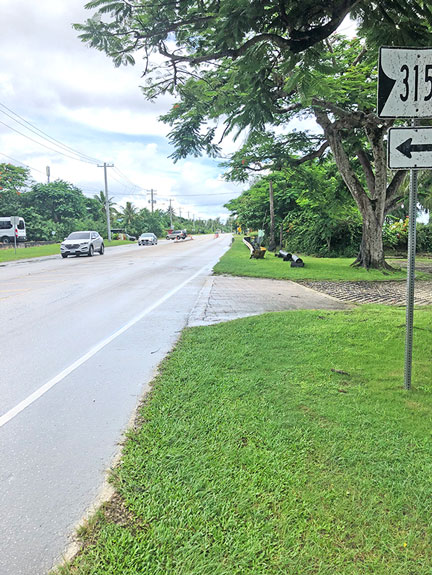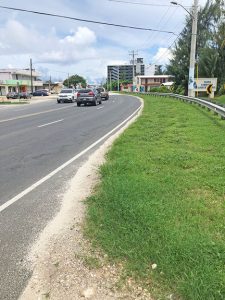Runners, bikers weigh in on implementation of 2002 law

The section of the Gov. Froilan C. Tenorio Beach Road Pathway where the Japanese Tank memorial is located is completely devoid of a dedicated bike lane. (Mark Rabago)
The Department of Land and Natural Resources’ sudden decision to finally implement a nearly 20-year law prohibiting bicycles along the Gov. Froilan C. Tenorio Beach Road Pathway has created a debate on social media that is unfortunately pitting the islands’ runners/walkers against the cycling community.
NMI Cycling Federation president Vince Seman said the solution is really simple, which is for the government to include a dedicated bike lane on the long-delayed planned facelift of Beach Road.
“This ideally could have been implemented in conjunction with the dedicated bike lane. There are parts of Beach Road that are really tight for automobiles and bicycles to share the road. Hopefully, some concessions for kids riding their bikes can also be accommodated,” he said.
Run Saipan coordinator Edward Dela Cruz couldn’t agree more, adding that for some riding a bike is not only to keep in shape but also a mode of transportation to and from work.
“Beach Road just needs to be updated with a more accommodating bike lane than what they have now. Biking is not just an exercise but a form of transportation for others. I understand why bikers don’t feel safe at on the roadway. It would be amazing if we can upgrade the bike lanes for them,” he said.
And Seman and Dela Cruz are right on the money on the sad state of the supposed bike lane along Beach Road as there are portions of the thoroughfare where the bike lane completely disappears like the section between First Hawaiian Bank and the Atkins Kroll intersection and the portion along the Japanese Tank memorial in Quartermaster.

The Beach Road bike lane inexplicably disappears in this section along the Saipan Community Church in Susupe. (Mark Rabago)
Saipan Cyclers Association’s Jay Diyco agrees with DLNR’s decision to enforce the 2002 law. “I think it’s okay since the pathway is mostly used by many for running and walking exercise. I sometimes see some bikers going too fast and putting the people using the pathway in danger if they will lose control of their bike.”
He, however, is willing to make concessions to those riding bikes to work. “It’s OK to use the pathway for bikers to commute to work but if it’s for exercise, it’s not a good idea for me. Biking or cycling is becoming popular on Saipan and I hope that our roads will be bike-friendly to encourage more people to bike for their health.”
Triathlon of the CNMI president Manny Sitchon said the law banning bikes along the Beach Road pathway has been in the books for nearly 20 years and it’s about time the government enforces it.
“For safety reasons people riding bikes or a motorized bike along the pathway should be banned. Especially there are bikers who just don’t care when they ride along the pathway.”
Sitchon, however, added that the government should improve the bike lanes along the roadway and also erect signs reminding motorists of the mandatory 3-foot distance a vehicle must give to a cyclist.
Champion biker Joel Buco said he doesn’t really use the Beach Road pathway when he practices and uses the highway instead because of preponderance of walkers and runners along the pathway.
Charlie Sendin, who like Sitchon runs and bikes, said it’s unfortunate that biking along the pathway is now illegal. “We all need to follow the law. I just wish for the safety of my fellow bikers.”
Butch Sublemente, another runner and biker, said to make everyone happy the government should make a better bike lane along Beach Road.
“That will allow cyclists to safely enjoy their favorite activity. It would also be good for attracting more tourists who love to explore the islands riding a bike. Protected bicycle lanes will make the roads safer for everyone. It doesn’t only keep people on bicycles alive but improve the safety of people driving and walking in the pathway as well. The bottom line is: everything the well-designed protected bike lane represents is positive. It is a pathway to health, progress, and safer for more citizens of the CNMI,” he said.
Press secretary Kevin Bautista said while cyclists have no choice but to abide by the law, the administration of Gov. Ralph DLG Torres is indeed working to redesign Beach Road with appropriate dedicated bike lanes in mind.
“In order to protect both pedestrians and bicyclists, DLNR will crackdown on the enforcement of bicyclists riding on the Gov. Froilan C. Tenorio Beach Road Pathway… The law has already been in place in the CNMI…The administration has initiated plans for bike lanes on all major thoroughfare, particularly Beach Road. We understand that this is not going to happen overnight, but this administration intends to get the ball rolling on projects that keep pedestrians safe on pedestrian walkways and cyclists on bike lanes,” he said.
Asked if DLNR would allow children to continue riding their bikes along the Beach Road pathway, Bautista said he would’ve to check with the agency but his initial thoughts are that it would probably be allowed.
“Will need to talk to DLNR. But that should be fine. Usually parents are walking behind their kids biking. It’s like a stroller,” he said.























